Paul Gilster's Blog, page 185
January 27, 2015
Enormous Ring System Hints of Exomoons
Might there be gas giant planets somewhere with moons as large as the Earth, or at least Mars? Projects like the Hunt for Exomoons with Kepler (HEK) are on the prowl for exomoons, and the possibility of large moons leads to astrobiological speculation when a gas giant is in its star’s habitable zone. Interestingly, we may be looking at evidence of an extremely young — and very large — moon in formation around a planet that circles the young star J1407.
That would be intriguing in itself, but what researchers at Leiden Observatory (The Netherlands) and the University of Rochester have found is an enormous ring structure that eclipses the young star in an epic way. The diameter of the ring system, based on the lightcurve the astronomers are getting, is nearly 120 million kilometers, which makes it more than two hundred times larger than the rings of Saturn. This is a ring system that contains about an Earth’s mass of dust particles, with a marked gap that signals the possibility of the large moon.
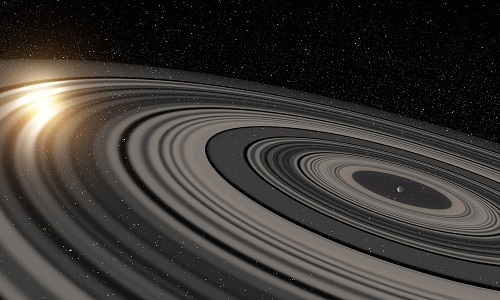
Image: Artist’s conception of the extrasolar ring system circling the young giant planet or brown dwarf J1407b. The rings are shown eclipsing the young sun-like star J1407, as they would have appeared in early 2007. Credit: Ron Miller.
The ring system itself was discovered in 2012 by Eric Mamajek (University of Rochester) and team, with Leiden’s Matthew Kenworthy and Mamajek now refining the observations and working out the details. What emerges is a ring system with over thirty separate rings. And you need to see the lightcurve, which is available below. Kenworthy’s enthusiasm about the find is evident:
“The details that we see in the light curve are incredible. The eclipse lasted for several weeks, but you see rapid changes on time scales of tens of minutes as a result of fine structures in the rings. The star is much too far away to observe the rings directly, but we could make a detailed model based on the rapid brightness variations in the star light passing through the ring system. If we could replace Saturn’s rings with the rings around J1407b, they would be easily visible at night and be many times larger than the full moon.”
Exoring model for J1407b from Matthew Kenworthy on Vimeo.
I love the many worlds presented to us in science fiction, but I’m hard pressed to come up with a depiction of anything quite like this. Says Mamajek:
“If you were to grind up the four large Galilean moons of Jupiter into dust and ice and spread out the material over their orbits in a ring around Jupiter, the ring would be so opaque to light that a distant observer that saw the ring pass in front of the sun would see a very deep, multi-day eclipse. In the case of J1407, we see the rings blocking as much as 95 percent of the light of this young Sun-like star for days, so there is a lot of material there that could then form satellites.”
The figure below, from the paper, gives a static view of the same data:

Image: From the paper. The caption reads: “Model ring fit to J1407 data. The image of the ring system around J1407b is shown as a series of nested red rings. The intensity of the colour corresponds to the transmission of the ring. The green line shows the path and diameter of the star J1407 behind the ring system. The grey rings denote where no photometric data constrain the model fit. The lower graph shows the model transmitted intensity I(t) as a function of HJD. The red points are the binned measured flux from J1407 normalised to unity outside the eclipse. Error bars in the photometry are shown as vertical red bars.” Credit: Matthew Kenworthy/Eric Mamajek.
As to J1407b, the planet these rings surround, the astronomers estimate that it has an orbital period of about a decade, with a mass most likely in the range of between ten and forty Jupiter masses. The gap in the ring structure points to a satellite in formation that has an orbital period of approximately two years around the gas giant. It becomes clear that if we can find more instances of early disks, we can begin to study comparative satellite formation around exoplanets. From the paper:
J1407 is currently being monitored both photometrically and spectroscopically for the start of the next transit. A second transit will enable a wide range of exo-ring science to be carried out, from transmission spectroscopy of the material, through to Doppler tomography that can resolve ring structure and stellar spot structure significantly smaller than that of the diameter of the star. The orbital period of J1407b is on the order of a decade or possibly longer. Searches for other occultation events are now being carried out (Quillen et al. 2014) and searches through archival photographic plates (e.g. DASCH; Grindlay et al. 2012), may well yield several more transiting ring system candidates.
The paper also points out possible ring structures around Fomalhaut b (anomalous bright flux in optical images) and Beta Pictoris b (anomalous photometry), though neither of these has been confirmed. The scientists involved are encouraging amateur astronomers to help monitor J1407 as the attempt to constrain the mass and period of the ringed planet J1407b continues. Observations can be reported to the American Association of Variable Star Observers (AAVSO).
The paper is “Modeling giant extrasolar ring systems in eclipse and the case of J1407b: sculpting by exomoons?” accepted for publication by the Astrophysical Journal (preprint).





January 22, 2015
Giovanni Vulpetti: Clarifying Magsail Concepts
Over the years we’ve looked at magnetic sail (magsail) concepts of various kinds and discussed whether a spacecraft could do such things as ‘riding’ the solar wind to high velocities, or use a stellar wind to brake against as it entered a destination solar system. But just how workable is the magsail? In a 2007 paper called “Theory of Space Magnetic Sail Some Common Mistakes and Electrostatic MagSail” now available on the arXiv site, Alexander Bolonkin argues that magsail concepts are unworkable because induced fields resulting from two-way interactions between the solar wind and the craft’s magsail disrupt the previously calculated effect.
In fact, Bolonkin believes that previous work on the matter is seriously compromised, as he said upfront in the abstract of his paper:
The first reports on the “Space Magnetic Sail” concept appeared more [than] 30 years ago. During the period since some hundreds of research and scientific works have been published, including hundreds of research report by professors at major famous universities. The author herein shows that all these works related to Space Magnetic Sail concept are technically incorrect because their authors did not take into consideration that solar wind impinging a MagSail magnetic field creates a particle magnetic field opposed to the MagSail field. In the incorrect works, the particle magnetic field is hundreds times stronger than a MagSail magnetic field. That means all the laborious and costly computations revealed in such technology discussions are useless: the impractical findings on sail thrust (drag), time of flight within the Solar System and speed of interstellar trips are essentially worthless working data!

Is it possible that the corpus of work on magnetic sail concepts should be disregarded? The matter came up in comments here several times in the past year as we discussed neutral particle beam propulsion (to a magsail) and other aspects of using such principles. I had no answer to the Bolonkin question but fortunately was able to turn to Giovanni Vulpetti for clarification. A well-known figure in the astronautics community, Dr. Vulpetti is a plasma physicist with extensive experience in both magnetic sail and photon sail studies. The author of over 100 papers and technical reports, and author and co-author respectively of Fast Solar Sailing, Astrodynamics of Special Sailcraft Trajectories (Springer (2012), and Solar Sails: A Novel Approach to Interplanetary Travel ( 2nd edition, Springer, 2015), Dr. Vulpetti was team coordinator for the Aurora Collaboration, which examined sail prospects in the 1990s. He has analyzed both solar and magnetic sail prospects exhaustively.
Image: Plasma physicist and deep space propulsion analyst Giovanni Vulpetti.
Dr. Vulpetti was kind enough to write an explanation of magnetic sail issues that includes background material on how the solar wind interacts with objects in space and examines the nature of plasma itself. He then analyzed Alexander Bolonkin’s objections to prior magsail studies and found them to be flawed. “[The] objection made by Bolonkin to ‘hundreds of researchers, professors at famous universities, audiences of specialists, . . .’ has no physical foundation, absolutely no basis,” was his conclusion, which was arrived at by a mathematical treatment that I had hoped to present in its entirety here on the main page of the site.
Unfortunately, formatting issues were a problem. The material in Dr. Vulpetti’s essay, I discovered, would not be as readable if squeezed into the Centauri Dreams format than if left in the form of the original PDF file. With the permission of the author, I have uploaded the PDF so that interested readers of a technical bent can see it in its original form. You can click on the link to read “Notes about misinterpreting some plasma properties,” a file that includes the figures and equations that were a challenge to reproduce effectively here. Let me take this opportunity to thank Dr. Vulpetti for his efforts, which are deeply appreciated especially in light of his busy schedule. It’s interesting to note in the essay why he himself moved primarily to photon sail work after 1992, drawn in this direction by other issues with magnetic sail spacecraft that make solar sails a far more manageable proposition.
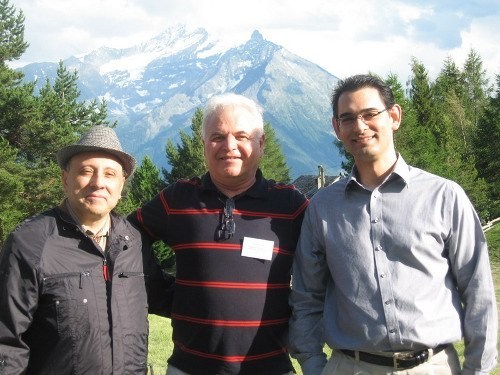
Image: I have to run this photo that I took years ago in the Italian Alps in remembrance of a wonderful afternoon and subsequent banquet during the Aosta interstellar conference. Dr. Vulpetti is at the left, with Roman Kezerashvili in the center and Justin Vazquez-Poritz at right.





January 21, 2015
Drake Equation: The Sustainability Filter
There are a lot of things that could prevent our species from expanding off-Earth and gradually spreading into the cosmos. Inertia is one of them. If enough people choose not to look past their own lifetimes as the basis for action, we’re that much less likely to think in terms of projects that will surely be multi-generational. That outcome doesn’t worry me overly much because it flies against the historical record. We have abundant evidence of long-term projects built by civilizations for their own purposes, and while we view pyramids or cathedrals differently than they did in their time, their artifacts show that humans are capable of this impulse. The Dutch dike system has been maintained for over 500 years, and precursor activity can be traced back as far as the 9th Century.
Nor am I concerned that most people won’t ever want to leave this planet. I have no ambition to leave it either, but in every era there have been small numbers of people who chose to leave what they knew to follow their impulses, whether they were explorers, exploiters or zealots. Given the opportunity, I’d say that spreading into the Solar System will happen as small outposts evolve into colonies, and colonies are gradually enlarged by the flow of the like-minded.
Or, at least, it will happen if we get past the L term in the famous Drake Equation, which on the level of technology describes the length of time a civilization can release detectable signals, and on a more profound level may describe the working lifetime of a technological society. It’s this factor that Adam Frank (University of Rochester) looks at in a recent New York Times essay. He’s studying the price we pay for developing a global industrial culture, wondering whether this ‘sustainability bottleneck’ may not account for the Fermi paradox; i.e., the lack of evidence for civilizations around nearby stars in an obviously fecund universe.

Image courtesy of University of Rochester.
Civilizations need energy to operate, and as Frank points out, waste (entropy) is an inevitable part of the process of energy generation. Humans harvest about 100 billion megawatt hours of energy every year, with the consequence that we put 36 billion tons of carbon dioxide into the biosphere. We can assume that other civilizations would face the same issues as they grew. We can also see the vast changes that both Mars and Venus have been through in our own Solar System as perhaps once habitable worlds were gradually transformed by natural processes. We’re beginning to piece together general rules that can help us understand what happens as biospheres change.
Some of this change happens without the mediation of living creatures, and some occurs because of them:
…any species climbing up the technological ladder by harvesting energy through combustion must alter the chemical makeup of its atmosphere to some degree. Combustion always produces chemical byproducts, and those byproducts can’t just disappear. As astronomers at Penn State recently discovered, if planetary conditions are right (like the size of a planet’s orbit), even relatively small changes in atmospheric chemistry can have significant climate effects. That means that for some civilization-building species, the sustainability crises can hit earlier rather than later.
Frank’s interest is in studying sustainability issues as a generic astrobiological problem. You’ll recall that we’ve looked at a paper of his on this idea before (see Astrobiology and Sustainability). Working with Woodruff Sullivan (University of Washington), Frank talks in reference to Species with Energy-Intensive Technology (SWEIT), and argues that we can profitably study not only other worlds but our own previous eras of climate alteration for insight. The research program that grows out of this models SWEIT evolution along with that of the planet on which it arises with a methodology based on dynamical systems theory.
Earth’s own past suggests how complex these interrelationships can be. There was a time about two billion years after the formation of the planet when anaerobic bacteria utterly changed the biosphere by driving up the oxygen content in the atmosphere, a form of what was then pollution eventually becoming an essential for life such as ours. Never mind technology — life itself can be a game-changer. With such principles in mind, Frank and Sullivan are interested in the ‘trajectories’ civilizations take as shaped by the choices they make, some of which could result in population collapse while others lead to long-lived technological societies.
It’s always possible, Frank speculates, that we have a Fermi paradox because no civilization makes it through its sustainability crisis. But there are models that indicate this doesn’t have to happen.
By studying sustainability as a generic astrobiological problem, we can understand if the challenge we face will be like threading a needle or crossing a wide valley. Answering this question demands a far deeper understanding of how planets respond to the kind of stresses energy-intensive species (like ours) place on them. It’s an approach no different from that of doctors using different kinds of animals, and their molecular biology, to discover cures for human disease.
So maybe we’re not the only ones to tackle these problems, which are the consequences of physical laws that govern the interactions between planets and the life they sustain. We don’t have enough knowledge to provide the answer, not yet, but the generic problem is one that advanced civilizations anywhere must at some time face. I leave it to specialists like Frank to discover whether the ‘needle’ or the ‘valley’ is the best metaphor. My own suspicion is that sustainability is a manageable matter, while civilizational collapse through inadvertence via war or accident is the more likely outcome. That’s the filter on L that keeps me up at night.
The Frank and Sullivan paper is “Sustainability and the astrobiological perspective: Framing human futures in a planetary context,” Anthropocene Vol. 5 (March 2014), pp. 32-41 (full text).





January 20, 2015
Dawn: New Imagery of Ceres
Mark January 26 on your calendar. It’s the day when the Dawn spacecraft will take images of Ceres that should exceed the resolution of the Hubble Space Telescope. We’re moving into that new world discovery phase that is so reminiscent of the Voyager images, which kept re-writing our textbooks on the outer Solar System. 2015 will be a good year for such, with Dawn being captured by Ceres gravity on March 6, and New Horizons slated for a July flyby of Pluto/Charon. In both cases, we will be seeing surfaces features never before observed.
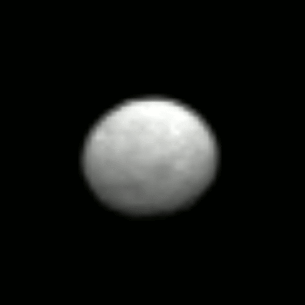
What we have so far from Dawn can’t match earlier Hubble imagery, the best of which is about ten years old, but it’s about three times better than the calibration images taken by the spacecraft in early December. At this point, Dawn is making a series of images to be used for navigation purposes during the approach to the dwarf planet. We have sixteen months of close study of Ceres to look forward to as the excitement builds. “Already,” says Andreas Nathues, lead investigator for the framing camera team at the Max Planck Institute for Solar System Research, Gottingen, “the [latest] images hint at first surface structures such as craters.”
Image: An animated GIF showing bright and dark features on Ceres. The Dawn spacecraft observed Ceres for an hour on Jan. 13, 2015, from a distance of 383,000 kilometers. A little more than half of its surface was observed at a resolution of 27 pixels. Credit: NASA/JPL.
No spacecraft has ever visited a dwarf planet, another first for Dawn, which will also become the first spacecraft to have orbited two deep space destinations following its 2011-2012 sojourn at Vesta, where it produced over 30,000 images. Jian-Yang Li (Planetary Science Institute), who led the Hubble mapping of Ceres, says that even the early observations will be significant:
“Reproducing the Hubble observations is important to understanding the nature of Ceres’ surface. The recent detection of episodic water vapor near Ceres’ surface by the Herschel Space Observatory at a longitude observed by Dawn might arise from activity that could change Ceres’ surface over time.”
That discovery, relying on data taken in 2012, took advantage of the HIFI instrument on Herschel, which showed water vapor being emitted from the surface of Ceres, an early indication that Ceres has an icy surface and an atmosphere. Variations in the water signal during the dwarf planet’s nine hour rotation period helped Herschel scientists trace the water vapor to two spots on the surface. The two emitting regions are about five percent darker than the rest of Ceres, likely warmer regions that provide efficient sublimation of small reservoirs of water ice. In very short order, thanks to the Dawn spacecraft, we will be able to observe such features in dazzling detail.
For more on the Herschel work, see Küppers et al., “Localized sources of water vapour on the dwarf planet (1) Ceres,” Nature 505 (23 January 2014), 525–527 (abstract).





January 19, 2015
Making the Case for Deep Space
I get few questions that are harder to answer than ‘what happened to the sense of adventure that we once had with Apollo?’ And there are few questions I get more often, usually accompanied by ‘how are we going to do starflight if we don’t even have the will to go back to the Moon?’ Both questions have unsettling answers, but the second question is open-ended. We can hope that the ‘sense of sag’ that Michael Michaud describes in talking about the post-Apollo period (for manned flight, at least) may itself evolve into something else, something far more hopeful.
But let’s dwell a moment on the first question. I’ve been looking over an essay Michaud wrote for Spaceflight in the mid-1970s, a decade of the Pioneers and the Voyagers, but also a decade when it became clear that our presence on the Moon with Apollo was going to be a short-lived affair. Instead, we were talking about Skylab, about docking operations between Soviet and American spacecraft, and the next big ticket item on the manned spaceflight agenda looked to be a reusable space shuttle. NASA wanted to deliver measurable returns, even when many of us were thinking ‘Wait! Weren’t we supposed to be headed on to Mars by now?’.
There were plenty of reasons for what some considered to be a more realistic assessment of Earth’s needs. The critics of Apollo argued that it was played as a card in the great geopolitical game of the Cold War, set up as a contest between two super-powers so that achieving the Moon meant the ‘race’ was over. We were dealing with enormous demands on spending, and space projects that could produce quantifiable results were the currency of the day. Instead of manned missions to the Moon, the goal was scientific observation of the Earth to improve our understanding of our ecosystem, to upgrade communications, to streamline navigation.
Nearby Space in Context
To our credit, the exploratory impulse remained, as the Pioneer and Voyager triumphs attest. But are we as a species destined to stay on the Earth or just above it in close orbit, letting our machines be our surrogates in deep space? A prolific essayist and author (Contact with Alien Civilizations (Copernicus, 2007),. Michaud is a former diplomat with global experience in US science policy. He argues here that such a limited view of manned spaceflight goes against the impulse that has long driven us toward expansion. Remember, this perspective is from the 1970s — our ‘sense of sag’ has been with us a long time:
Historically, spaceflight has had a philosophical purpose: to carry man to the stars. From early pioneers such as the Russian Tsiolkovsky and the American Goddard to contemporary writers such as Arthur C. Clarke, there was a consistent line of thinking: build the machines that will allow man to escape the confines of Earth and explore the Universe, and expand the realm of the human race. But military exploitation of the rocket and Cold War competition in space diverted our thinking, and Project Apollo ultimately left us unsatisfied because it had a short-term goal and did not lead directly to anything else. While Apollo proved that man could reach another sphere, it did not leave a step to be built upon.
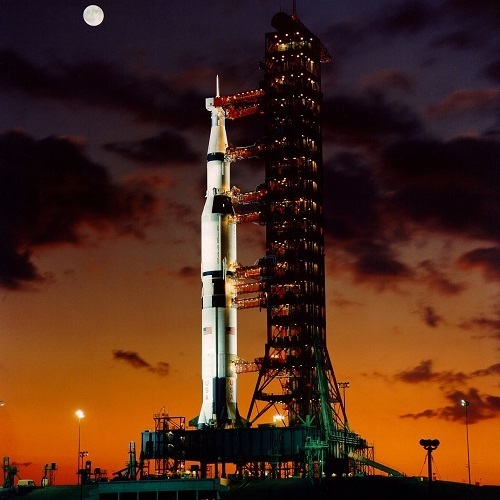
Image: Saturn V at twilight and, at upper left, its target. Credit: NASA.
I agree completely with Michaud that a major problem with Apollo was the fact that it was in every sense a crash program. The US found itself, post-Sputnik, trying to catch up to a rapidly moving Soviet program that was setting new records in space almost monthly. In fact, looking back at how we pushed the envelope with missions like Apollo 8, I’m astounded that we didn’t lose more than one Apollo crew (and at that, the one we did lose died in a training accident). We put a crew on a never-before attempted journey outside Earth orbit to the Moon and back, launching Apollo 8 with a rocket that had never been used for a manned mission (Apollo 7 flew a less powerful variant of the Saturn rocket). It seemed dicey at the time, but from the perspective of half a century later, it seems like utter folly. The results were, of course, magnificent.
But while we still play Apollo 8’s Christmas Eve transmission from lunar orbit on YouTube and elsewhere, we’re trying to work out the next bold steps for the manned space program in a very tentative way. If Mars is truly our objective, it’s an objective that’s only vaguely in our plans for the 2030s, the kind of goal that all too easily recedes a decade at a time. NASA may or may not complete the Space Launch System, but are we sure what we will do with it? Elon Musk wants to die on Mars — does SpaceX and Falcon Heavy awaken any sort of Apollo-like passion?
Spaceflight and Evolution
For some of us, the old passion never died, but when it comes to the general public, we’re dealing with a case that has to be made all over again. If we take an evolutionary perspective, the purpose of human life, argues Michaud, is survival, as it is for all forms of life. How to broaden our survival options is a question of how we can upgrade our evolutionary potential. From the essay:
The tools for the improvement of our survivability are guided evolution, conflict limitation, a balanced relationship to our Earthly environment, and space flight. The first three can improve our chances anywhere that humans live, but are presently limited to the Earth’s biosphere. Only space flight can give man the option of surviving no matter what happens on Earth, of spreading the human race throughout the universe, of opening up new environments for long-term human evolution.
There’s that phrase again: ‘long-term.’ To engage the public in a program for human expansion into the cosmos is to reverse the Apollo preoccupation with crash programs and near-term wins. A rational program to achieve starflight is not likely to happen against a ticking clock. Rather, it will be an effort that sustains itself philosophically across the decades and centuries such an effort will require, crossing many human generations. It will be an exploratory and expansionist meme that remains alive because its triggers are fundamental to our nature as human beings.
Let me quote Edmund Burke on this, because the views of the 18th Century political theorist and philosopher are much to the point:
[Society] is not a partnership in things subservient only to the gross animal existence of a temporary and perishable nature. It is a partnership in all science, a partnership in all art; a partnership in every virtue, and in all perfection. As the ends of such a partnership cannot be obtained in many generations, it becomes a partnership not only between those who are living, but between those who are living, those who are dead, and those who are to be born. Each contract of each particular state is but a clause in the great primeval contract of eternal society.
Specifically, spaceflight challenges human capabilities and stimulates intellectual innovation. We are forced to develop new techniques, new materials and new forms of cooperation as we engage with a frontier more hostile than any we have known. Yes, these technologies will produce tangible results on Earth, many of which are obvious, from communications to power-generation. Mastering closed biospheres will teach us a great deal about our Earth. But we are also driven on a purely intellectual level to learn more about the cosmos, an engagement that broadens our understanding of physical law and provides context for all our science.
End of the Space Race
A goal of interstellar flight is not reached with a ‘space race’ mentality, although competition can boost interim steps — it will be interesting, for example, to see how the Western democracies react to a potential Chinese presence on the Moon. But the interstellar goal is too big to be comprehended by its individual components. It is a goal that begins in the short-term to expand our presence in the Solar System, reaping rewards like enhanced energy production and access to materials made available through exploitation of asteroids and other resources. There is in Michaud’s view a powerful encouragement to international cooperation in all this, for cutting costs if nothing else. Underlying early expansion is the reduction of existential risk, but also the possibility of diversifying the species as humans in new environments inevitably adapt.
Culturally, there is little to parallel the growth in philosophical perspective that may be gained by interacting with societies beginning to take hold in O’Neill-style colonies or on nearby planets like Mars, just as the Renaissance in Europe was bolstered by the influx of ideas and commodities from voyages of exploration. We might add a SETI imperative as well. If we do one day make contact with an extraterrestrial species, our own development off our world will likely be seen as an evolutionary step that is reproduced elsewhere in the universe. The potential growth in knowledge from such contact emphasizes space-based strategies to maximize the search.
All of these are short-term but necessary goals, each building on the other. But unlike Apollo, the species must have the broader context to work with. As Michaud writes:
Even if funding for major new projects seems unlikely now, interest must be kept alive. Industrial, labour, military, and scientific interests will continue to be important for the future of space flight, but farsighted political leaders also must mobilize public support with the excitement of exploration and discovery, of expansion and new opportunities, of the change in man’s place in the universe. They must hold out the promise of new and better lives, not just for a few astronauts, but for ordinary people.
None of this is easy to sell, but the collapse of interest post-Apollo should not be allowed to take hold as an inevitable consequence of success in space. The argument for a deep space exploration program is one that needs to be made again and again, for public sentiment changes slowly without precipitating events. But interplanetary growth must not become an end in itself. Interstellar flight, as Michaud reminds us, is open-ended. It opens before us an all but infinite frontier. That frontier is woven into our psychological and philosophical DNA as much as it is entwined with our evolutionary need for survival. We must continue to make the case.
The paper is Michaud, “After Apollo,” Spaceflight Volume 15 (October 1973), pp. 362-367.





January 16, 2015
Planets to Be Discovered in the Outer System?
Having just looked at the unusual ‘warped’ disk of HD 142527, I’m inclined to be skeptical when people make too many assumptions about where planets can form. Is our Solar System solely a matter of eight planets and a Kuiper Belt full of debris, with a vast cometary cloud encircling the whole? Or might there be other small planets well beyond the orbit of Neptune, planets much larger than dwarfs like Pluto but not so large that we have been able to detect them?
Certainly Carlos de la Fuente Marcos and Raúl de la Fuente Marcos (Complutense University of Madrid), working with Sverre J. Aarseth (University of Cambridge) think evidence exists for this proposition. The scientists are interested in how large objects can affect the trajectories of small ones, and in particular what a comet named 96P/Machholz 1 can reveal about how such interactions work. They’re focused on the Kozai mechanism, which explains how the larger object causes a quantified libration in the smaller object’s orbit, and use the Jupiter-family comet as a reference to understand the processes that may be happening in the outer Solar System.
Objects like Sedna are in extreme orbits that extend out hundreds of AU, with even their closest approach to the Sun well beyond the orbit of Pluto. And the the orbits of Sedna itself and others among the group the authors call ‘extreme trans-Neptunian objects’ (ETNOs) show enough discrepancies from what we would expect to point to the existence of larger objects affecting their orbits, just as Jupiter affects Comet 96P/Machholz 1. Carlos de la Fuente Marcos explains:
“This excess of objects with unexpected orbital parameters makes us believe that some invisible forces are altering the distribution of the orbital elements of the ETNO and we consider that the most probable explanation is that other unknown planets exist beyond Neptune and Pluto. The exact number is uncertain, given that the data that we have is limited, but our calculations suggest that there are at least two planets, and probably more, within the confines of our solar system.”
We’ve recently discovered 2012 VP113, evidently another object orbiting far beyond Pluto, whose own orbit has been suggested as evidence for an undiscovered super-Earth with up to ten times the mass of our planet orbiting in a region perhaps 250 AU from the Sun. The work on 2012 VP113 by Chadwick Trujillo and Scott Sheppard is invoked by the new research, which argues that dwarf worlds like Sedna and other ETNOs may signal the existence of a large population of similar small ETNOs. Moreover, the gravitational perturbations of the outer system evident in their orbits point to something larger, as one of the two papers on the work notes:
…the architecture of that region is unlikely to be the result of a gravitationally unperturbed environment. If there are two planets, one at nearly 200 au and another one at approximately 250 au, their combined resonances may clear the area of objects in a fashion similar to what is observed between the orbits of Jupiter and Saturn.
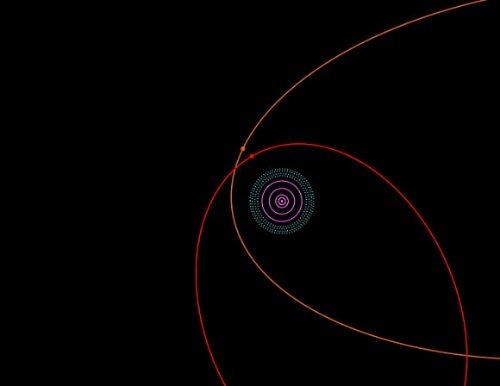
Image: This is an orbit diagram for the outer Solar System. The Sun and Terrestrial planets are at the center. The orbits of the four giant planets, Jupiter, Saturn, Uranus and Neptune, are shown by purple solid circles. The Kuiper Belt, including Pluto, is shown by the dotted light blue region just beyond the giant planets. Sedna’s orbit is shown in orange while 2012 VP113′s orbit is shown in red. Both objects are currently near their closest approach to the Sun. Credit: Scott Sheppard.
So while we have no evidence for planets the size of Jupiter or Saturn moving in circular orbits in the outer system, the possibility of small planets beyond Neptune may still be in play, even if a wave of recent interest has resulted in no detections. The current authors think their results are unlikely to be the result of perturbations caused by Neptune or of observational bias, even while stressing that their work is based on the behavior of a relatively small number of objects. Can a moderate-sized planet affect objects beyond Pluto’s orbit in ways that New Horizons could detect? The authors think it’s possible, and it’s an interesting thought, particularly now that New Horizons is actually entering the first of its encounter phases for the Pluto/Charon flyby.
The papers are de la Fuente Marcos et al., “Flipping minor bodies: what comet 96P/Machholz 1 can tell us about the orbital evolution of extreme trans-Neptunian objects and the production of near-Earth objects on retrograde orbits.” Monthly Notices of the Royal Astronomical Society Vol. 446, Issue 2, pp. 1867-1873 (abstract / preprint) and de la Fuente Marcos, “Extreme trans-Neptunian objects and the Kozai mechanism: signalling the presence of trans-Plutonian planets,” Monthly Notices of the Royal Astronomical Society Vol. 443, Issue 1, pp. L59-L63 (abstract / preprint). On 2012 VP113, see Trujillo & Sheppard, “A Sedna-like body with a perihelion of 80 astronomical units,” Nature 507 (27 March 2014), pp. 471–474 (abstract).





January 15, 2015
Naming Names in the Cosmos
How objects in the sky get named is always interesting to me. You may recall that the discovery of Uranus prompted some interesting naming activity. John Flamsteed, the English astronomer who was the first Astronomer Royal, observed the planet in 1690 and catalogued it as 34 Tauri, thinking it a star, as did French astronomer Pierre Lemonnier when he observed it in the mid-18th Century. William Herschel, seeing Uranus in 1781, thought at first that it was a comet, and reported it as such to the Royal Society.
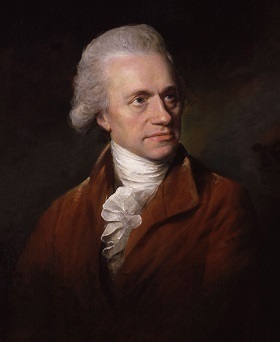
By 1783, thanks to the work of the Russian astronomer Anders Lexell and Berlin-based Johann Elert Bode, Herschel came to agree that the new object was indeed a planet. Herschel, asked by then Astronomer Royal Nevil Maskelyne to name the new world, declared it to be Georgium Sidus, the ‘Georgian Planet,’ a name honoring King George III. The unpopular name soon met with alternative suggestions, including Herschel, Neptune and (Bode’s own idea) Uranus.
Image: Sir William Herschel (1738-1822), whose idea about naming a new planet met with scant approval. Credit: Lemuel Francis Abbott – National Portrait Gallery.
Herschel had worried that naming planets after the ‘ principal heroes and divinities’ of ancient eras would be out of place in his time, suggesting that naming them after the era they were discovered (hence, the reign of George III) would be the more satisfactory method. But of course we haven’t followed the suggestion, and now look not only for the names of ancient beings both human and divine as well as names related to specific cultures. The geography of Ceres, for example is to be named after mythology associated with agriculture and vegetation, a nod to Giuseppe Piazzi, its discoverer, who knew Ceres as the Roman goddess of agriculture.
The problem with all this is that we’re making so many discoveries that we’re taxing our ability to come up with the best nomenclature. Some 24 craters on Saturn’s moon Phoebe have been named by classical reference to the Argonauts, the intrepid adventurers who sailed with Jason to find the Golden Fleece. But the also notes that future craters on Phoebe may have names associated with the goddess, who was, according to ancient lore, a Titan, the daughter of Uranus and Gaea. As mapping continues, features other than craters may acquire names based on Appollonius Rhodius’ 3rd C. text The Argonautica.
Titan, much in our thoughts with the 10th anniversary of the landing of the Huygens probe, gets plenty of attention from the International Astronomical Union, the U.S. Geological Survey, and NASA, all of whom have a hand in determining the names of features. Craters on the Saturnian moon take the names of gods and goddesses of wisdom, while a variety of surface features are open to names drawn from characters from Tolkien’s Middle Earth, characters from the Foundation series by Isaac Asimov and the names of planets from Frank Herbert’s Dune novels, surely a nod to science fictional interests among researchers.
And let’s not forget Xanadu, a plateau-like, highly reflective region on Titan, a name deriving ultimately from the Yuan Dynasty’s summer capital as established by Kublai Khan and immortalized in the West by Samuel Taylor Coleridge. Interesting places, these new worlds, and full of so many features that need names! When Makemake was discovered soon after Easter in 2005, it was immediately nicknamed Easterbunny, but later yielded to an IAU-sanctioned monicker based on fertility mythology on Rapa Nui, which most of us know as Easter Island.
I could go on with this entertaining subject indefinitely, even sticking within our own Solar System. The Uranian satellite Miranda, for instance, draws feature names from characters in Shakespeare’s plays, as do all the major moons of Uranus, though small satellites can draw on names from the poetry of Alexander Pope. We’ll doubtless have plenty of suggestions for features on Pluto once New Horizons gets close enough to see them. The theme there will be underworld deities. New moons like Nyx and Hydra have already received names according to this convention.
What happens when we turn to exoplanets? With so many being discovered, it’s no surprise that the International Astronomical Union has organized a global contest to name selected exoplanets. The NameExoWorlds contest is already open, with a first round that will allow nominations for ExoWorlds (by this, the IAU means the entire exoplanetary system and its host star) to be made available for the next stage of the contest, where names can be proposed.
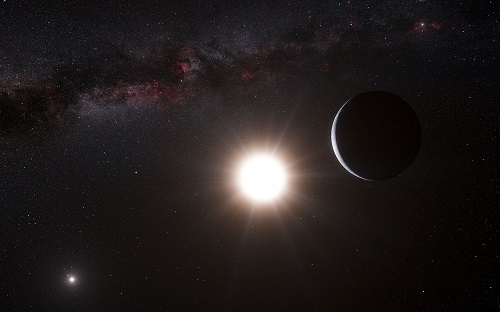
Image: An artist’s impression of Alpha Centauri Bb. How many place names will we eventually have to come up with for places like this? Credit: ESO/L. Calçada/Nick Risinger.
The IAU, which goes about assigning scientifically recognized names to newly discovered objects, says that the NameExoWorlds contest will be the first opportunity for the public to name both exoplanets and the stars around which they orbit. To participate, clubs and non-profit organizations have to register with the IAU Directory of World Astronomy by May 15, 2015. The deadline for the first stage of the contest is February 15, 2015, when the nominating process for the first 20 ExoWorlds is to close. After that, each club or organization will be allowed to submit names, with a later worldwide public vote that will presumably take place over the Internet.
If you’d like to get involved, this IAU news release has all the details. News of the contest had me thinking about new categories for names, and I immediately thought about drawing ideas from Arthurian romances of the Middle Ages. But alas, I learn from the Gazetter of Planetary Nomenclature that this one has already been taken, on Mimas, of all places, where craters are to be named after people from Malory’s Morte d’Arthur. Malory scooped up most of the major characters in earlier English and French Arthurian tales, but maybe there are a few he missed. It’s worth a look, because as we keep discovering new worlds, names are going to be in short supply.





January 14, 2015
HD 142527: Shadows of a Tilted Disk
About a year ago we looked at a young star called HD 142527 in the constellation Lupus (see HD 142527: An Unusual Circumstellar Disk). A T Tauri star about five million years old, HD 142527 has drawn attention because it shows evidence of both an inner and an outer disk, each of which may be capable of producing planets. These are disks with a twist, as astronomers at the Millennium ALMA Disk Nucleus project at the Universidad de Chile demonstrate in a new paper that explains the three-dimensional geometry of this unusual system.
HD 142527’s two disks are striking because no other star shows a gap this large between an inner and outer disk, a gap that spans a region from 10 AU out to 120 AU. Two dark regions stand out in observations of the outer disk that break its continuity. The new study reveals these outer disk features to be caused by the shadow of the inner disk. The shape and orientation of the shadows thus become a measure of the inner disk’s orientation. Using radiative transfer methods that analyze the absorption, emission and scattering of light, the researchers find that the inner disk has to be tilted by about 70 degrees to produce the known features.
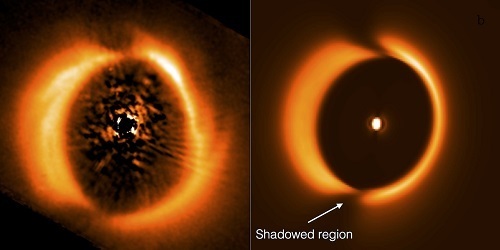
Image: Comparison between the the observed infrared image of HD142527 (left) and the result of the warped inner disk model (right) as predicted by radiative transfer calculations. Shadows correspond to the two dark regions or intensity nulls seen in the upper and bottom sections of the outer disk. Credit: Henning Avenhaus/Millenium ALMA Disk Nucleus.
We’re left with the puzzle of how this system came to be in this unusual configuration. One possibility, suggested in 2014, is a relatively recent close encounter with another star, although lead author Sebastian Marino argues in the paper that no candidate has yet been identified. Interactions between the circumstellar disks and possible proto-planets are more likely, and we have an example in the debris disk around Beta Pictoris where an inner disk was apparently influenced by a young planet whose orbit is aligned with an inclined warped disk component.
But that answer raises questions as well, notes Sebastian Perez, a co-author of the paper:
“The astounding fact is that this planet would most likely need to be in a highly inclined orbit, just like the inner parts of the disk. Which poses more interesting questions about the dynamical stability of such arrangement.”
It’s interesting to speculate on how shadowing like this might affect planet formation, given that the shadows create regions colder and denser than the rest of the outer disk. And can we generalize from the HD 142527 disks? This finding, notes the paper, “… poses a challenge to understand the dynamics of the HD 142527 system, and is an invitation to interpret scattered light images of gapped protoplanetary disks from the perspective of inner warp shadows.”
The paper is Marino et al., “Shadows cast by a warp in the HD 142527 protoplanetary disk,” Astrophysical Journal Letters Vol. 798, No. 2, L44 (abstract / preprint). A news release from the Millenium ALMA Disk Nucleus project is available.





January 13, 2015
A Stellar Correlation: Spin and Age
Figuring out how fast a star spins can be a tricky proposition. It’s fairly simple if you’re close by, of course — in our Solar System, we can observe sunspot patterns on our own star and watch as they make a full rotation, the spin becoming obvious. From such observations we learn that how fast the Sun spins depends on where you look. At the equator, the rotation period is 24.47 days, but this rotation rate decreases as you move toward the poles. Differential rotation means that some regions near the Sun’s poles can take as much as 38 days to make a rotation.
Because of these issues, astronomers have chosen an area about 26 degrees from the equator, where large numbers of sunspots tend to appear, as the point of reference, giving us a rotation of 25.38 days. You can imagine how complicated solar rotation gets once we look at other stars. We can’t resolve them to begin with, much less their ‘starspots,’ but what we can do is measure the decrease in light that starspots cause as they rotate around the star. You can see why studying a lightcurve like this resembles searching for transiting exoplanets, and in fact a mission like Kepler has to take the possibility of false positives from starspots into account.
Determining the Age of a Star
Stars between 80 and 140 percent of the Sun’s mass are the subject of new work on stellar spin by Søren Meibom (Harvard-Smithsonian Center for Astrophysics) and team. Using Kepler data, the researchers homed in on a 2.5 billion year old cluster called NGC 6819, part of a continuing investigation of stellar spin rates. Meibom’s work is part of the broader Kepler Cluster Study, for which he is the principal investigator. The work uses data from the original Kepler mission, the four years of data before the current K2 mission, to study star clusters.
The goal is to develop a precise method of obtaining the ages of stars like these, a method co-author Sydney Barnes (Leibniz Institute for Astrophysics) calls ‘gyrochronology.’ Stellar spin is the critical factor because stars slow down as they age, while other indicators, like size, temperature, and brightness, stay relatively constant. So far we’ve been able to use spin rate to determine stellar ages only with fast-spinning stars in young clusters. Starspot activity is prominent on young stars and thus easier to detect. We’re also helped by the fact that the pattern of color and brightness in a cluster can give us a good read on the overall cluster’s age.
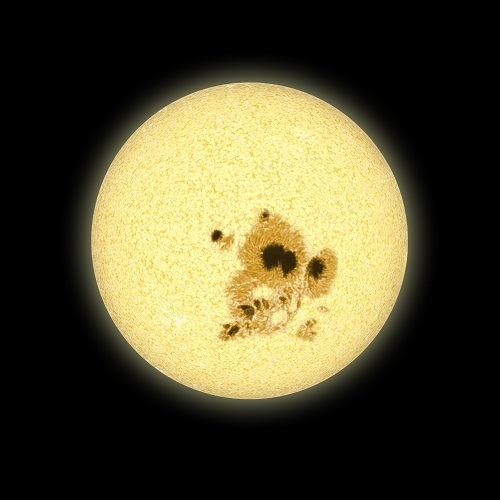
Image: It’s easier to tell the age of a young star because they rotate more quickly and have larger starspots. Credit: David A. Aguilar (CfA).
Thus we can correlate spin rate with age in specific instances. Get beyond about 600 million years in stellar age, though, and there is a huge gap between these young stars and stars as old as our 4.6 billion year old Sun. How fast do stars of intermediate ages spin? In this video on his work, Meibom refers to the ‘four billion year gap’ created.by our inability to measure spin for older stars. Young, rapidly spinning stars with large starspot regions, where brightness changes are pronounced, show a far more marked lightcurve than older stars, where starspot activity has dropped and teasing out the spin rate takes us to the limit of our instruments’ capabilities.
The Kepler telescope’s exquisitely sensitive measurements of stellar brightness are what has allowed us to fill in the gap. Studies of the cluster NGC 6811 produced the first measurements for the spin rate of one billion year old stars in 2011. Analyzing NGC 6819 data, Meibom and team have now been able to measure spin rates for 30 2.5 billion year old stars. We can thus plot spin against age on a far more meaningful graph, allowing us to extrapolate that when the Sun was 2.5 billion years old, its spin rate was roughly 18 days, with the rate dropping to eleven days when the Sun was 1 billion years old. A stellar ‘clock’ like this can help us determine which stars have planets that have had time for complex life to evolve. Looking forward, studying planets like our own around much older stars will give us clues to what lies ahead for the Earth.
“Now we can derive precise ages for large numbers of cool field stars in our Galaxy by measuring their spin periods,” says Meibom. “This is an important new tool for astronomers studying the evolution of stars and their companions, and one that can help identify planets old enough for complex life to have evolved.”
The paper is Meibom et al., “A spin-down clock for cool stars from observations of a 2.5-billion-year-old cluster,” published online in Nature 5 January 2015 (abstract). Links to the full text, and to video of the AAS press conference where these findings were announced, are available along with much more material on stellar age here. A CfA news release is also available.





January 9, 2015
Spaceward Ho!
How do you go about creating a straightforward, highly durable design for a spacecraft, one that is readily refuelable and offers manifest advantages for crew comfort and safety? Alex Tolley and Brian McConnell have been asking that question for some time now, coming up with an ingenious solution that could open up large swathes of the Solar System. Alex tells me he is a former computer programmer now serving as a lecturer in biology at the University of California, where he hopes to inspire the next generation of biologists. He’s also a Centauri Dreams regular who was deeply influenced by 2001: A Space Odyssey and the Apollo landings. Below, he fills us in on the details in a narrative that imagines an early trip on such a vessel.
by Alex Tolley

The covered wagon or prairie schooner is one of the iconic images of the 19th century westward migration of the American pioneers. The wagon was simple in construction, very rugged, and repairable. They were powered most often by oxen that lived on the food and water found along the trail. The cost of a wagon, oxen and supplies was about 6 months of family wages.
In 2009 my colleague Brian McConnell and I were thinking about how to open up the exploration of space in an analogous way to the opening up of the American West during the 19th century pioneering era. We were looking for an approach that, like the covered wagon, was affordable, relatively low tech, provided safety in the case of emergencies and the space environment, could “live off the land” for propulsion like oxen, and preferably was reusable so that costs could be amortised over a number of flights.
What follows is a description of the “spacecoach” from the perspective of a new crew member making a first visit to the ship that will be on a Phobos return mission.

Image: ‘Ships of The Plains’ by Samuel Colman.
————————-
Our transfer vehicle docked gently with the Martian Queen airlock. On approach, the Martian Queen resolved into 4 fat sausages, linked end to end. On either side, from bow to stern, were solar PV arrays, partially unfurled. She looked like no spaceship seen since the dawn of the space age.. There was no gleaming metal hull, and she was devoid of all the encrustations of antennae and dishes of those earlier ships. Neither were there any signs of fuel tanks holding liquid cryofuels. Instead, the hull looked dull and somewhat like an old blimp, those non-rigid airships of the early 20th century. The only sign of exterior equipment were those solar PV panels. These were lightweight, moderate performance thin film arrays, extended out on booms to face the sun and drink her rays to power the ship. They looked more like square rigged sails as they fluttered every so gently in the tenuous atmosphere remaining at her orbit.
I knew from the briefing that the Martian Queen needed about 160KW of power, requiring about 800 m2 of arrays at Mars orbit. There was also talk of the next generation “spacecoaches” replacing the PV panels with lightweight rectennas, to convert microwave beams from the orbital transmitters. Most crews didn’t trust that idea yet, but adding a lightweight rectenna was considered a good idea to back up the PVs and also compensate for the lower intensity of sunlight as the newer ships were about to explore Jupiter space. So this was the Martian Queen, the “spacecoach” that would be my home, about to make her 2nd voyage to Phobos.
Following my crew mate Vicki, I passed through the airlock and entered a large space, nearly 60 m3 in volume, shaped like a large cylinder. The interior diameter was about 4.5 meters, about the same as the mothballed Orion I’d seen back at the Cape museum.. But with a length of 10 meters, the volume was 3x larger. The Martian Queen was composed of 4 modules, providing over 200 m3 of full sea level atmosphere pressurized volume, about 2/3rds that of the old Mir space station. Touching the inner skin of the hull it felt flexible, and slightly cool to the touch. A few light taps and the resonant sounds confirmed that there was liquid behind the skin.
Vicki answered my unspoken question about the liquid in the hull. Water was sandwiched between several layers of impermeable Kevlar in the hull. The primary, and ultimately end, use of all the water was for propellant. The spacoach had originally been folded for launch in a standard Falcon 9 fairing. Each module, without any propellant, weighed just 4 tonnes including payload. This was very little and reduced the deadweight mass of the ship. Once in orbit, the interior had been inflated and the hull filled with water. Most of that water had been launched by dumb, low cost boosters, but some was being supplied from extra-terrestrial resources. Supplies from the lunar south pole were becoming increasingly available as Chevron-Petrobras’ Shackleton base was building up mining production. Exploratory vessels were also initiating operations on asteroids, with 24 Themis looking promising with confirmed surface water. In a few decades, it was expected that all water would be supplied from extra-terrestrial sources.
“Why do you put all the water in the hull, rather than in separate tanks?” I asked.
Vicki explained that the water had a number of roles, not just as propellant. The primary reason was radiation protection. The water acted as a good radiation shield, with a halving of the radiation flux with every 18 cm. Starting with about 25 cm of water in the hull, the radiation level inside the module was just 40 percent of that striking the hull. In the event of a major solar flare, the crew could also redirect the water to an interior tube to provide the best radiation shielding for the crew. It looked like that space could get very cozy for the crew, but better than suffering radiation burns.
But it didn’t end there. Micrometeoroids are a rare, but important hazard. The water acted as a shield, absorbing the energy of these grains and preventing penetration inside the hull. The tiny holes in the outer layers quickly heal too. The outer layers of water could be allowed to freeze, trapping a dense forest of fine fibers between the 2 outer fabric layers. This made a strong material, very much like pykrete [1] that offered a stiff outer hull to protect against larger impacts. At Earth’s 1 AU from the sun, reflective foils deployed over the hull allowed passive freezing of the outer layers providing both protection and a large heat sink for the engines.
A noticeable side effect of the hull architecture was the silence. There are no clicks and bangs from thermal heating stresses. Nor did the sunward side of the interior feel noticeably warmer. Thus the water was going to offer very good thermal control of the interior, with pumps in the hull circulating the water providing dynamic thermal control.
Vicki indicated that I should follow her forward to another module. This included the kitchen and dining space. There was a freezer of dried food packages that was being organized by Pieter. Enough for a long trip with a fair variety of meals.
“You seem to have ordered a lot of Boeuf Bourguignon”, joked Pieter.
I wondered when the taste of Boeuf Bourguignon would become rather tiresome after some months. Perhaps more spicy meals like curries would have been more appropriate. I noted that the water supply for rehydrating the food and drinks was connected to the hull too. Of course, I reminded myself, the hull was a huge reservoir of water, effectively inexhaustible are far as the crew was concerned, at least on the outward bound flight.
The facilities were oriented so that “down” was towards the end of the module. This was because during cruise the Martian Queen was going to be rotated, providing some artificial gravity. This made the flight much more comfortable and familiar. We could even eat off regular plates.
Vicki quickly showed me the crew quarters and bathroom in the next module. The inner skin of the hull had been moulded into shapes that could contain water. The baths and showers were also connected to the hull’s water supply. The clean water input was connected to heaters and pumps to the various faucets and shower heads. The grey water from the drains was routed to the main purifier and returned to the hull. I inquired how frequently I could take a shower? Once, twice even three times a week?
“As much as you like”, said Vicki. “There is ample water supply for a single pass through the purifier for all the crew to shower once or twice a day. If the crew is particularly extravagant, even this can be increased with greater recycling. Hygiene is a huge morale booster on these trips.”
The toilet was apparently a composting type, although suitably modified for space. This made sense. The nitrogen and phosphorus was going to be needed for the plants growing in the interior, as well as the Phobos base agricultural areas. Nitrogen and phosphorus were still valuable elements with no rich, off-Earth supplies available. Ducking back into the kitchen space, it was clear that much of the interior was given over to growing plants. They provided the needed psychological connection with Earth, helped recycle the CO2, and freshened the air, removing unpleasant volatiles. The stale, locker room smell of most spaceships was almost absent. Some plants were also growing some fresh foods. I could just imagine the value of a fresh tomato after 6 months of spaceflight!
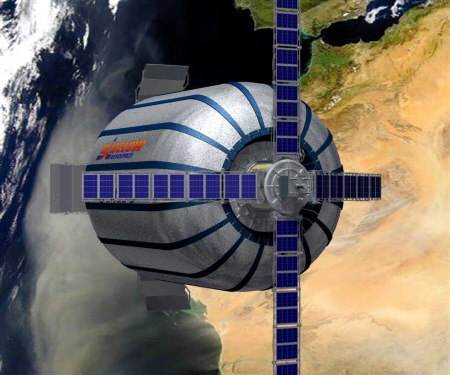
Image: The Genesis 2 space module. An inflatable habitat launched in 2007 and still operational. A design concept similar to the spacecoach. Credit: Bigelow Aerospace (http://www.bigelowaerospace.com).
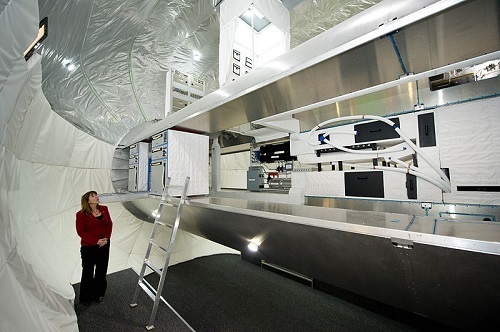
Image: Inside Bigelow Aerospace Space Station Alpha mockup. This is similar to the spacecoach basic module before addition of specialized fixtures and fittings. Credit: Bigelow Aerospace.
Pulling ourselves back through the leafy interior of the modules, I looked for the engine compartment in the last module. The engines were not obvious on docking, and I wondered where they were. At the rear of the last module, an airlock was currently open, showing an enclosed space beyond. Inside, Hans, the engineer was taking apart one of the engines. He was removing a metal liner from the engine and replacing it with a fresh one. He handed the old one to me and said “carbon deposits”.
I looked closely and saw what he was talking about. Carbon deposition from contaminants in the water supply could build up in the engines, reducing performance. The engines were not much more complex than microwave ovens, although they were fitted with electric grids to further accelerate the microwave heated water plasma.
The exhaust exited via the rear, when the bay doors were opened. Now they were closed, allowing the shirt sleeve repair of the engines. I asked how frequent engine repairs were. Hans informed me that an engine needed some rework after 3-6 hours of operation. The microwave electrothermal engine performance had an Isp of about 800s, although the secondary electric grids could double that by drawing on reserve energy from the solar arrays. Vicki thanked Hans and we drifted back to the main module.
I was a little surprised at the lack of windows, but pleased that there were many flat screens where windows should have been. I looked “out” and saw that I had missed the vernier and maneuvering jets on the hull.
“How are these powered?” I asked Vicki.
“Hydrogen Peroxide, H2O2” she replied.
“Where’s the fuel?”.
“There isn’t any yet. It’s made during the flight. Some of the water in the hull is tapped off, run through that off-the-shelf, standard unit over there. We store the peroxide in hull pockets to wait for the next use. The peroxide engines aren’t very efficient, having an Isp of about 160s, but they provide higher thrust than the main engines and can be used to boost the ship for a faster departure, or land the ship on low gravity worlds with orbital delta-Vs of 0.5 km/s or less. The peroxide has other uses too. It can be decomposed to provide oxygen [3] more quickly than the main ESS electrolyzers, act as an energy store for emergency power [4] and finally as an excellent bactericide to keep the interior clean and remove the bacterial slimes and molds that grow on the inner skin, often in difficult to reach spaces. And before you ask, yes, we have rotating cleaning duties on the Martian Queen.”
So the water in the hull fulfilled a range of uses, before being finally consumed as propellant. Major uses included bathing, direct consumption, rehydrating food, growing plants and, of course, the main oxygen supply. It was converted to peroxide for the high thrust engines, for energy storage and for another emergency O2 supply.
“Vicki, a quick mental calculation seems to come up short on the water requirement for the flight. Is what I see all that is needed?”
Vicki smiled: “The impact of using water as propellant on performance is significant. The total water budget for the trip is about 4 times the total mass of the ship and payload, compared to about 14 times for a conventional liquid hydrogen and LOX chemical rocket, primarily because of the higher Isp of the electrothermal engines. But the low hull mass and reduced consumables payload reduces the main mass of the the Martian Queen allowing a much smaller, more efficient spaceship. She is also a lot roomier, more comfortable and much safer. An Apollo 13 type accident would not be survivable in a conventional ship, but we have very large reserves of consumables and oxygen for the crew to survive until a rescue or the return trajectory was complete. In addition, even without water supplies at Phobos, the baseline mission cost to Phobos and return is on the order of a $100m dollars. That is why your institution can afford to pay for your slot on this mission. Reusability of the Martian Queen for multiple missions, fresh water at Phobos, and better performing solar panels and electric engines will eventually reduce that cost perhaps another order of magnitude.”
I pondered that for a moment. While not a cheap solution for interplanetary travel, it put the cost well within the realm of the super-rich and wealthy institutions. A mere decade earlier, a simple lunar flyby and return in an adapted Soyuz craft was priced at around $100m per passenger by Space Adventures. Spaceflight was definitely getting cheaper and safer.
————————-
If interplanetary travel is initially based around the design concepts of water propellant craft, then the economics and infrastructure requirements will be dependent on available supplies of water already in space at suitable locations for fuel dumps. Bodies that may harbor economically useful quantities of accessible water include the moon (shadowed polar regions), water rich asteroids and dead comets. A tantalizing possibility is Ceres, that Dawn is expected to rendezvous with this year (2015). Ceres is expected to have prodigious quantities of frozen water, possibly even a subsurface ocean. A mining operation to extract pure water from the brew of ice and chemicals might offer the opportunity to open up the inner solar solar system. Once at Jupiter, the icy moons offer an almost inexhaustible supply of water.
References
1. Pykrete http://en.wikipedia.org/wiki/Pykrete
2. Bigelow Aerospace B330 http://bigelowaerospace.com/b330/
3. 47kg O2/1000 kg H2O2 (10%)
4. ~2 MJ, kg.
5. J E Brandenburg, J Kline and D Sullivan, “The microwave electro-thermal (MET) thruster using water vapor propellant,” Plasma Science, IEEE Transactions on (Volume:33, Issue:2) pp 776-782 (2005).
6. E. Wernimont, M. Ventura, G. Garboden and P. Mullens. “Past and Present Uses of Rocket Grade Hydrogen Peroxide”, http://www.hydrogen-peroxide.us/history-US-General-Kinetics/H2O2_Conf_1999-Past_Present_Uses_of_Rocket_Grade_Hydrogen_Peroxide.pdf





Paul Gilster's Blog
- Paul Gilster's profile
- 7 followers



